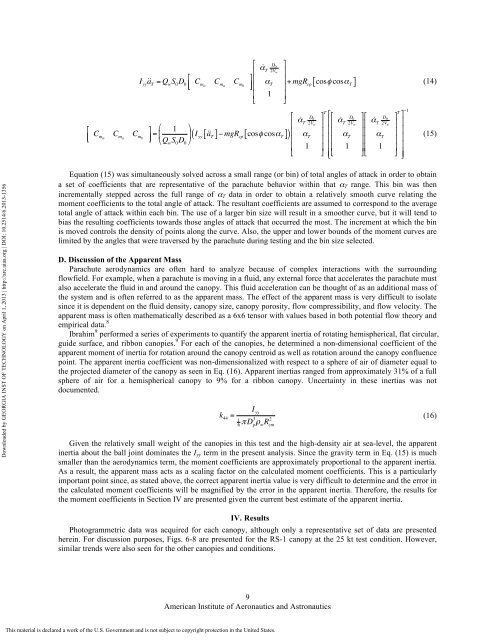Aerodynamic Stability and Performance of Next-Generation ...
Aerodynamic Stability and Performance of Next-Generation ...
Aerodynamic Stability and Performance of Next-Generation ...
Create successful ePaper yourself
Turn your PDF publications into a flip-book with our unique Google optimized e-Paper software.
!<br />
"#<br />
C m α<br />
C mα<br />
C m0<br />
I yy<br />
a T<br />
= Q w<br />
S 0<br />
D<br />
!<br />
0<br />
C m α<br />
C mα<br />
C<br />
"#<br />
m0<br />
$<br />
%& = ' 1 *<br />
) , I yy<br />
a T<br />
( Q w<br />
S 0<br />
D 0 +<br />
!<br />
#<br />
$ #<br />
%& #<br />
#<br />
"<br />
α T<br />
D 0<br />
2V w<br />
α T<br />
1<br />
$<br />
&<br />
&<br />
&<br />
&<br />
%<br />
( [ ] − mgR cp [ cosφ cosα T ])<br />
+ mgR cp [ cosφ cosα T ] (14)<br />
!<br />
#<br />
#<br />
#<br />
#<br />
"<br />
α T<br />
D 0<br />
2V w<br />
α T<br />
1<br />
T<br />
$ !!<br />
& ##<br />
& ##<br />
& ##<br />
& ##<br />
% "#<br />
"<br />
α T<br />
D 0<br />
2V w<br />
α T<br />
1<br />
$ !<br />
&#<br />
&#<br />
&#<br />
&#<br />
%"<br />
α T<br />
D 0<br />
2V w<br />
α T<br />
1<br />
−1<br />
T<br />
$ $<br />
& &<br />
& &<br />
& &<br />
& &<br />
% %&<br />
(15)<br />
Downloaded by GEORGIA INST OF TECHNOLOGY on April 1, 2013 | http://arc.aiaa.org | DOI: 10.2514/6.2013-1356<br />
Equation (15) was simultaneously solved across a small range (or bin) <strong>of</strong> total angles <strong>of</strong> attack in order to obtain<br />
a set <strong>of</strong> coefficients that are representative <strong>of</strong> the parachute behavior within that α T range. This bin was then<br />
incrementally stepped across the full range <strong>of</strong> α T data in order to obtain a relatively smooth curve relating the<br />
moment coefficients to the total angle <strong>of</strong> attack. The resultant coefficients are assumed to correspond to the average<br />
total angle <strong>of</strong> attack within each bin. The use <strong>of</strong> a larger bin size will result in a smoother curve, but it will tend to<br />
bias the resulting coefficients towards those angles <strong>of</strong> attack that occurred the most. The increment at which the bin<br />
is moved controls the density <strong>of</strong> points along the curve. Also, the upper <strong>and</strong> lower bounds <strong>of</strong> the moment curves are<br />
limited by the angles that were traversed by the parachute during testing <strong>and</strong> the bin size selected.<br />
D. Discussion <strong>of</strong> the Apparent Mass<br />
Parachute aerodynamics are <strong>of</strong>ten hard to analyze because <strong>of</strong> complex interactions with the surrounding<br />
flowfield. For example, when a parachute is moving in a fluid, any external force that accelerates the parachute must<br />
also accelerate the fluid in <strong>and</strong> around the canopy. This fluid acceleration can be thought <strong>of</strong> as an additional mass <strong>of</strong><br />
the system <strong>and</strong> is <strong>of</strong>ten referred to as the apparent mass. The effect <strong>of</strong> the apparent mass is very difficult to isolate<br />
since it is dependent on the fluid density, canopy size, canopy porosity, flow compressibility, <strong>and</strong> flow velocity. The<br />
apparent mass is <strong>of</strong>ten mathematically described as a 6x6 tensor with values based in both potential flow theory <strong>and</strong><br />
empirical data. 8<br />
Ibrahim 9 performed a series <strong>of</strong> experiments to quantify the apparent inertia <strong>of</strong> rotating hemispherical, flat circular,<br />
guide surface, <strong>and</strong> ribbon canopies. 9 For each <strong>of</strong> the canopies, he determined a non-dimensional coefficient <strong>of</strong> the<br />
apparent moment <strong>of</strong> inertia for rotation around the canopy centroid as well as rotation around the canopy confluence<br />
point. The apparent inertia coefficient was non-dimensionalized with respect to a sphere <strong>of</strong> air <strong>of</strong> diameter equal to<br />
the projected diameter <strong>of</strong> the canopy as seen in Eq. (16). Apparent inertias ranged from approximately 31% <strong>of</strong> a full<br />
sphere <strong>of</strong> air for a hemispherical canopy to 9% for a ribbon canopy. Uncertainty in these inertias was not<br />
documented.<br />
I yy<br />
k 44<br />
=<br />
(16)<br />
1 2<br />
6<br />
π D p3<br />
ρ ∞<br />
R cm<br />
Given the relatively small weight <strong>of</strong> the canopies in this test <strong>and</strong> the high-density air at sea-level, the apparent<br />
inertia about the ball joint dominates the I yy term in the present analysis. Since the gravity term in Eq. (15) is much<br />
smaller than the aerodynamics term, the moment coefficients are approximately proportional to the apparent inertia.<br />
As a result, the apparent mass acts as a scaling factor on the calculated moment coefficients. This is a particularly<br />
important point since, as stated above, the correct apparent inertia value is very difficult to determine <strong>and</strong> the error in<br />
the calculated moment coefficients will be magnified by the error in the apparent inertia. Therefore, the results for<br />
the moment coefficients in Section IV are presented given the current best estimate <strong>of</strong> the apparent inertia.<br />
IV. Results<br />
Photogrammetric data was acquired for each canopy, although only a representative set <strong>of</strong> data are presented<br />
herein. For discussion purposes, Figs. 6-8 are presented for the RS-1 canopy at the 25 kt test condition. However,<br />
similar trends were also seen for the other canopies <strong>and</strong> conditions.<br />
9<br />
American Institute <strong>of</strong> Aeronautics <strong>and</strong> Astronautics<br />
This material is declared a work <strong>of</strong> the U.S. Government <strong>and</strong> is not subject to copyright protection in the United States.
















